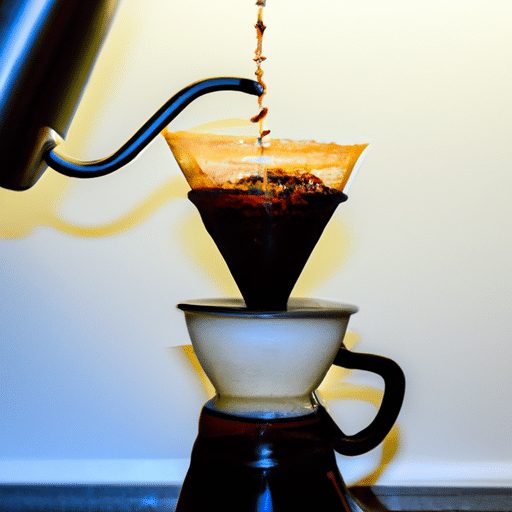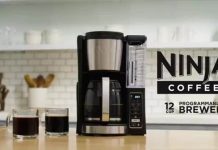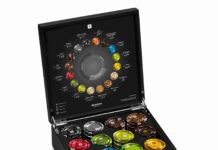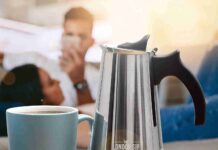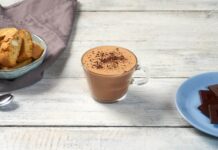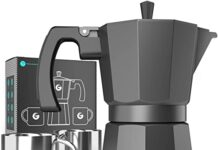If you’re a coffee lover like us, you may have come across the terms “drip coffee maker” and “pour over coffee maker” and wondered, what’s the difference? Well, fret not, because we’re here to break it down for you. In a nutshell, a drip coffee maker is a convenient and time-saving machine that automates the coffee brewing process, while a pour over coffee maker offers a more hands-on and precise brewing method. So, whether you prefer a no-fuss approach or enjoy the art of coffee making, we’ll help you figure out which one suits your coffee cravings best.
Definition of a Drip Coffee Maker
A drip coffee maker is a popular household appliance used to brew coffee. It is designed to automate the brewing process, making it convenient and hassle-free. With a drip coffee maker, water is poured into a reservoir, which is then heated and dripped over ground coffee beans. The brewed coffee then drips down into a carafe or pot, ready to be served.
How a Drip Coffee Maker Works
The operation of a drip coffee maker is fairly straightforward. First, cold water is poured into the reservoir. The water is then heated to the optimal brewing temperature, usually around 195 to 205 degrees Fahrenheit (90 to 96 degrees Celsius). Once heated, the water is dripped through a showerhead or spout and evenly distributed over the ground coffee in a filter basket. As the hot water passes through the coffee, it extracts the flavors and oils, creating the brewed coffee. The resulting liquid then drips down into a carafe or pot, which is usually kept warm by a heating plate.
Advantages of Drip Coffee Makers
Drip coffee makers offer several advantages that make them a popular choice for many coffee lovers. One of the main advantages is convenience. With a drip coffee maker, you can simply pour water in, add coffee, press a button, and wait for your coffee to brew. It requires minimal effort and allows you to multitask while waiting. Drip coffee makers also tend to be more affordable compared to other brewing methods, making them accessible to a wide range of people. Additionally, drip coffee makers often have a larger capacity, allowing you to brew multiple cups at once, which is great for households with multiple coffee drinkers or when hosting guests.
Disadvantages of Drip Coffee Makers
While drip coffee makers are convenient and affordable, they do have some disadvantages worth considering. One drawback is that they may not produce the same level of flavor and complexity as other brewing methods, such as pour over. The automated brewing process of drip coffee makers may not allow for the same level of control and precision when it comes to water temperature, extraction time, and coffee-to-water ratio. Additionally, some drip coffee makers use paper filters, which may absorb oils and flavors from the coffee, resulting in a slightly different taste compared to other brewing methods.
Definition of a Pour Over Coffee Maker
A pour over coffee maker, also known as a manual drip brewer, is a brewing device that allows for more control and precision in the brewing process. It involves manually pouring hot water over ground coffee, which then drips through a filter into a cup or carafe.
How a Pour Over Coffee Maker Works
Using a pour over coffee maker involves a simple but hands-on process. First, a paper or reusable filter is placed in a pour over cone or dripper. The coffee grounds are then added to the filter, and hot water is poured over the grounds in a slow, circular motion. The water passes through the coffee, extracting flavors and oils, and drips down into the cup or carafe below. The process requires more attention and involvement compared to a drip coffee maker, as you control the water flow and can adjust variables such as water temperature, brewing time, and grind size to tailor the coffee to your preferences.
Advantages of Pour Over Coffee Makers
Pour over coffee makers offer several advantages for those seeking a more hands-on brewing experience. One of the main advantages is the level of control you have over the brewing variables. With pour over, you can adjust the water temperature, pour rate, and brewing time to achieve the desired flavor profile. This control allows for a more precise extraction, potentially enhancing the overall taste and aroma of the coffee. Additionally, pour over coffee makers are often compact and require minimal countertop space, making them ideal for small kitchens or areas with limited storage.
Disadvantages of Pour Over Coffee Makers
While pour over coffee makers offer control and precision, they also come with certain drawbacks. First and foremost, they require more time and effort compared to drip coffee makers. The manual pouring process can be time-consuming, especially if you are brewing multiple cups or serving a group of people. Pour over brewing also requires a bit of skill and practice to master the technique and achieve consistent results. Additionally, pour over coffee makers may not be suitable for those seeking a quick and convenient brewing method, as the process requires attention and cannot be left unattended.
Overall Design and Structure
Drip Coffee Maker Design
Drip coffee makers typically feature a compact and appliance-like design. They often have a rectangular or cylindrical shape, with a water reservoir at the back or side, a filter basket in the middle, and a carafe or pot positioned below to collect the brewed coffee. The design is often user-friendly, with clear indicators for water levels, brewing functions, and a power switch. Some drip coffee makers may also incorporate additional features such as programmable timers, adjustable brewing strength, and automatic shut-off functions for added convenience.
Pour Over Coffee Maker Design
Pour over coffee makers come in various designs, but they commonly consist of a conical or flat-bottomed dripper, which sits on top of a cup or carafe. The dripper is usually made of materials like ceramic, glass, or stainless steel and may have spiral or ridged inner walls to aid in water flow and extraction. The design of pour over coffee makers is often minimalistic and aesthetically pleasing, making them a popular choice for coffee enthusiasts who value both functionality and style. Some pour over coffee makers may include a built-in stand or handle for added stability and ease of use.
Brewing Process
Drip Coffee Maker Brewing Process
The brewing process of a drip coffee maker involves several key steps. First, cold water is poured into the reservoir. The machine then heats the water to the desired brewing temperature. Once heated, the water is distributed over the coffee grounds by a showerhead or spout, saturating them evenly. The water slowly drips through the coffee, extracting the flavors and oils, and filters down into a carafe or pot. The brewed coffee is kept warm on a heating plate, allowing for easy serving and enjoyment.
Pour Over Coffee Maker Brewing Process
The brewing process of a pour over coffee maker is more hands-on and involves manual pouring of hot water. After placing a filter in the pour over cone or dripper and adding coffee grounds, hot water is poured over the grounds in a slow, circular motion. The water cascades over the coffee, allowing for even saturation and extraction. As the water passes through the filter, it drips down into the cup or carafe below, resulting in a flavorful and aromatic brew. The process can be repeated for multiple cups, adjusting the pouring technique and timing as desired.
Brew Control
Drip Coffee Maker Brew Control
Drip coffee makers offer limited brew control compared to pour over coffee makers. While some models may allow for customization of brewing strength or the ability to adjust the amount of water used, they generally have preset brewing parameters. This lack of control may limit the ability to fine-tune the brewing process according to personal preferences.
Pour Over Coffee Maker Brew Control
Pour over coffee makers provide a high level of brew control, allowing users to adjust various brewing variables. With pour over, you have control over the water temperature, pour rate, and brewing time. This level of control allows for a more personalized and precise brewing experience, enabling coffee aficionados to experiment with different combinations to achieve their desired flavor profile.
Brewing Time
Drip Coffee Maker Brewing Time
Drip coffee makers are designed to brew coffee relatively quickly. The brewing time depends on factors such as the machine’s capacity, brewing temperature, and the desired strength of the coffee. On average, a drip coffee maker can brew a full carafe of coffee within 5 to 8 minutes, providing a convenient and time-efficient brewing method.
Pour Over Coffee Maker Brewing Time
Pour over coffee makers generally have a longer brewing time compared to drip coffee makers. This is due to the manual pouring process, which requires more time and attention. The brewing time varies depending on factors such as the pour rate, grind size, and personal preferences. On average, a pour over coffee maker can take anywhere from 3 to 5 minutes to brew a single cup of coffee.
Cost
Drip Coffee Maker Cost
Drip coffee makers are available at a wide range of price points, making them an affordable option for most consumers. Basic models can be found for as little as $20 to $50, while more advanced and feature-rich machines can range from $100 to $300 or more. The cost of a drip coffee maker depends on factors such as the brand, brewing capacity, extra features, and build quality.
Pour Over Coffee Maker Cost
Pour over coffee makers tend to be more affordable compared to high-end drip coffee makers. Basic pour over sets, including a dripper and filters, can be found for as little as $10 to $20. Mid-range pour over options, made from premium materials like ceramic or glass, typically range from $20 to $50. High-end pour over coffee makers, featuring specialized designs or crafted from high-quality materials, can cost upwards of $100.
Maintenance
Drip Coffee Maker Maintenance
Drip coffee makers require regular maintenance to ensure optimal performance and longevity. Cleaning the machine regularly, especially the carafe, filter basket, and water reservoir, is essential to prevent the buildup of oils, minerals, and stale coffee residue. Many drip coffee makers come with a removable filter basket and water reservoir, making it easier to clean and maintain. It is also recommended to descale the machine periodically to remove mineral deposits and keep the brewing process efficient. Following the manufacturer’s instructions and using recommended cleaning solutions and filters can help prolong the life of a drip coffee maker.
Pour Over Coffee Maker Maintenance
Maintaining a pour over coffee maker is relatively simple compared to a drip coffee maker. After each use, the dripper and filter should be rinsed with warm water to remove any remaining coffee grounds. If using a reusable filter, it can be washed with mild soap and water. Ceramic or glass pour over coffee makers can also be cleaned in a dishwasher, although hand washing is typically recommended. It is important to handle pour over coffee makers with care to avoid accidental breakage, especially if made from delicate materials like glass.
Flavor and Aroma
Drip Coffee Maker Flavor and Aroma
Drip coffee makers often produce a consistent and familiar flavor profile that many people enjoy. The automated brewing process, although it may have limited control, can still result in a balanced and flavorful cup of coffee. However, due to the use of paper filters, some of the coffee’s oils and flavors may be absorbed, potentially impacting the overall taste. The aroma produced by a drip coffee maker is generally pleasant and can fill the room as the coffee brews.
Pour Over Coffee Maker Flavor and Aroma
Pour over coffee makers are known for producing a clean and vibrant flavor profile with complex nuances. The manual pouring process allows for better control over variables such as water temperature, extraction time, and pour rate, which can result in a more precise and personalized extraction. Additionally, the use of paper filters or reusable metal filters can result in a cleaner cup of coffee with more pronounced flavors. The aroma produced by a pour over coffee maker is often more pronounced and fragrant, as the coffee is brewed slowly and with more attention to detail.
Additional Features
Drip Coffee Maker Additional Features
Drip coffee makers can come with various additional features to enhance the brewing experience. Some models offer programmable timers, allowing you to set a specific time for the coffee maker to start brewing, ensuring your coffee is ready when you wake up or arrive home. Other features may include adjustable brewing strength settings, which allow you to customize the coffee’s intensity according to your preferences. Some drip coffee makers also come with automatic shut-off functions, which turn off the machine after a certain period of time, providing peace of mind and energy savings.
Pour Over Coffee Maker Additional Features
Pour over coffee makers are generally more focused on simplicity and manual brewing methods. As such, they tend to have fewer additional features compared to drip coffee makers. However, some higher-end pour over options may incorporate unique designs or features for added functionality. For example, certain pour over drippers may have specially designed spiral or ridged walls to aid in water flow and extraction. Others may include a built-in stand or handle, providing stability and ease of use.


